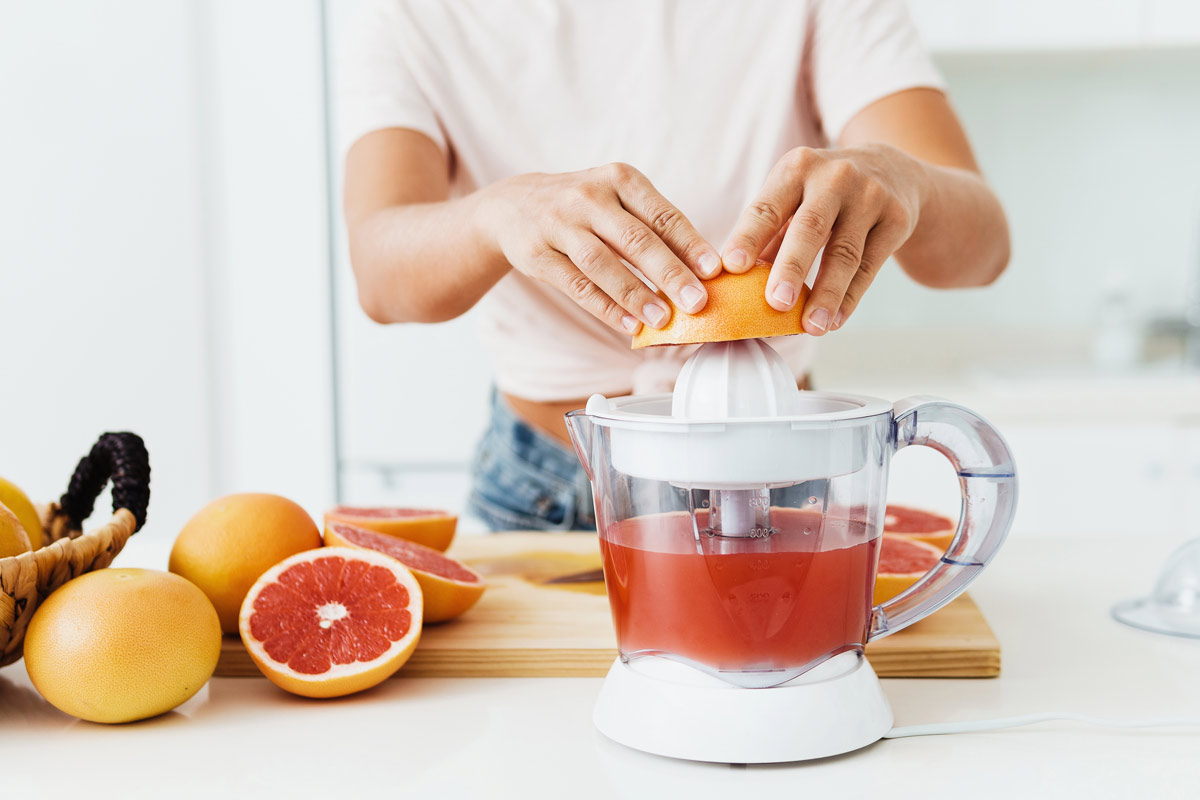Orange-Raspberry Muffins Recipe, Spotlight on Almond Flour, Juicing Fruit, The Benefits of Limiting Processed and Red Meats, and High Intensity Interval Training (HIIT)
Packaged gluten-free baked goods are often tasteless, not to mention filled with additives and other unhealthy ingredients. In just a few minutes, you can bake your own delicious muffins that are so tasty that they won’t provoke eye rolls from gluten lovers. While gluten should be avoided only by those with a sensitivity or celiac disease, a recent study found that everyone can benefit from eating fewer processed and red meats—the health benefits are astounding. Then read about a newly discovered benefit of high-intensity interval training (HIIT).
Orange-Raspberry Muffins
 Orange-Raspberry Muffins
Orange-Raspberry MuffinsThe combination of olive oil and almond flour creates a tender crumb that rivals any flour-based batter and a muffin that’s infinitely more nutritious. I like to use “tulip-shaped” cupcake liners because you can fill them right up to the level of your baking tin for very tall muffins. Also, topping the batter with berries after filling the liners helps keep the fruit from falling to the bottom.
Ingredients
- 3 cups almond flour
- 1-1/2 teaspoons baking powder
- 1/2 teaspoon fine sea salt
- 3/4 cup extra-virgin olive oil
- 1/2 cup sugar, divided use
- Freshly grated zest of 1 large orange
- 1/2 cup fresh orange juice
- 6 eggs, separated
- 1 tablespoon vanilla paste
- 1 cup raspberries
Directions
Step 1
Preheat your oven to 350°F. Place tulip-shaped cupcake liners in the cups of a 12-muffin tin; set aside.
Step 2
In a large bowl, sift together the almond flour, baking powder, and salt. In a separate bowl, whisk together the olive oil, 1/4 cup sugar, orange zest and juice, egg yolks, and vanilla. Fold in the flour mixture.
Step 3
In a very large bowl or the bowl of a stand mixer, beat the egg whites on a low speed to break them up, about a minute. Once they start to foam, increase the speed to high and add the remaining sugar. Whip until the whites form stiff peaks, then use a large spatula to gently fold them into the almond flour mixture in 3 or 4 batches, rotating your mixing bowl as you move your spatula from the center out to the sides. Don’t overmix to avoid deflating the batter—a few streaks of whites are OK.
Step 4
Use a large ice cream scoop to fill the paper liners up to the level of your baking tin. Top with equal amounts of berries. Bake the muffins for 30 to 40 minutes, until the tip of a sharp knife comes out clean. Serve warm or at room temperature.
Yields 12 muffins

Healthy Ingredient Spotlight
Almond Flour
Almond flour, like other nut flours, is wonderful for baking, whether you’re making muffins, a cake like a dacquoise or torte, cookies, or even pie shells. You can grind your own from fresh almonds or buy it by the bag. Some brands are made of blanched almonds, but those made with the almond skins offer even more nutrients. Like almonds themselves, almond flour is naturally rich in vitamin E and other antioxidants, manganese, and magnesium, with a healthy dose of protein and fiber. To keep it fresh, store it in the fridge or freezer.

Quick Kitchen Nugget
Juicer or Hand Squeezer?

When a recipe calls for any type of citrus juice, fresh-squeezed is a must. The question then becomes whether to use a hand press or an electric citrus juicer. The answer depends on how much juice you’ll be making.
For a few tablespoons up to a cup, a metal hand press (look for one with ergonomic handles) will work well with minimal strain on your hands—it does take effort to squeeze its handles together, and you might need different sizes for juicing limes, lemons, and oranges effectively. For juicing large quantities, it pays to have an electric juicer for ease and speed; this countertop appliance can handle all sizes of citrus and can be stored in a cabinet when not needed. There are also large, commercial-grade manual juicers that sit on a flat surface and that you operate by pushing down on a lever to extract the juice, but these tend to take up a lot of counter space.

For Your Best Health
The Benefits of Limiting Processed and Red Meats
While many studies have identified links between frequent consumption of processed meat and chronic disease, few have evaluated the impact on multiple health outcomes. Some previous research also suggested that unprocessed red meat may contribute to chronic disease risk, but evidence has been limited.
Now, a team from the University of Edinburgh’s Global Academy of Agriculture and Food Systems, together with researchers from the University of North Carolina, Chapel Hill, has used data from a Centers for Disease Control and Prevention national health survey to create a simulated, representative sample of the US adult population—called a microsimulation—in order to estimate how changes in meat consumption affect adults’ risk of diabetes, cardiovascular disease, colorectal cancer, and death. The effects were evaluated in the overall population and separately based on age, sex, household income, and ethnicity.
This microsimulation is the first to estimate the effects of reducing processed meat and unprocessed red meat consumption, from between 5 percent and 100 percent, on multiple health outcomes in the US. They found that cutting processed meat intake by 30 percent (the equivalent of around 10 slices of bacon a week) would prevent more than 350,000 cases of diabetes and lead to 92,500 fewer cardiovascular disease cases and 53,300 fewer colorectal cancer cases over a decade.
The researchers also analyzed the impacts of reducing unprocessed red meat intake alone and cutting consumption of both processed meat and unprocessed red meat. Cutting unprocessed red meat intake alone by 30 percent, which would mean eating around one less quarter-pound beef burger a week, resulted in more than 732,000 fewer diabetes cases, 291,500 fewer cardiovascular disease cases, and 32,200 fewer colorectal cancer cases. Reducing consumption of both by 30 percent resulted in 1,073,400 fewer diabetes cases, 382,400 fewer cardiovascular disease cases, and 84,400 fewer colorectal cancer cases.
The finding that more disease cases were prevented by reducing unprocessed red meat than by reducing processed meat is partly due to the average daily intake of unprocessed red meat being higher than that of processed meat, at 47 grams a day versus 29 grams a day, respectively. As less is known about the effect of eating unprocessed red meat on chronic disease risk, the team said these estimates should be interpreted with caution and that more research is needed.
Lindsay Jaacks, PhD, professor, Personal Chair of Global Health and Nutrition at the University of Edinburgh, and one of the authors of the study, said, “Cutting consumption of meat has been recommended by national and international organizations to reduce greenhouse gas emissions, including by the Climate Change Committee here in the UK and the United Nations Intergovernmental Panel on Climate Change. Our research finds that these changes in diets could also have significant health benefits in the US, and so this is a clear win-win for people and planet.”
The study, “Estimated effects of reductions in processed meat consumption and unprocessed red meat consumption on occurrences of type 2 diabetes, cardiovascular disease, colorectal cancer, and mortality in the USA: a microsimulation study,” was published in TheLancet Planetary Healthand was funded by the Wellcome Trust.

Fitness Flash
An Exercise Brain Boost That Can Last for Years

A longitudinal study led by Emeritus Professor Perry Bartlett, PhD, and Daniel Blackmore, PhD, of the University of Queensland’s Queensland Brain Institute found that high-intensity interval exercise improves brain function in healthy older adults for up to five years. The research was published inAging and Disease.
Dr. Bartlett said it is the first controlled study of its kind to show that exercise can not only delay cognitive decline but also boost cognition in healthy older adults. “Six months of high-intensity interval training (HIIT) is enough to flick the switch,” Dr. Bartlett said. “In earlier preclinical work, we discovered exercise can activate stem cells and increase the production of neurons in the hippocampus, improving cognition. In this study, a large cohort of healthy 65- to 85-year-old volunteers joined a six-month exercise program, did biomarker and cognition testing, and had high-resolution brain scans.”
During the study, the researchers assessed the impact of three exercise intensities: low—predominantly motor function, balance, and stretching; medium—brisk walking on a treadmill; and high—four cycles of running on a treadmill at near maximum exertion. Participants exercised three times a week, for between 36 and 45 minutes per session including warmup and cooldown, and under supervision for 6 months.
Dr. Blackmore said only the high-intensity interval exercise led to cognitive improvement that was retained for up to five years. “On high-resolution MRI scans of that group, we saw structural and connectivity changes in the hippocampus, the area responsible for learning and memory,” he said. “We also found blood biomarkers that changed in correlation to improvements in cognition. Biomarkers can be useful in predicting the effectiveness of the exercise a person is doing.”
Aging is one of the biggest risks for dementia, a condition that affects almost half a million Australians. “If we can change the trajectory of aging and keep people cognitively healthier for longer with a simple intervention like exercise, we can potentially save our community from the enormous personal, economic, and social costs associated with dementia,” Dr. Bartlett said.
With one out of three people aged 85 likely to develop dementia, Dr. Blackmore said, the impact of the research is far-reaching. “Our finding can inform exercise guidelines for older people and further research could assess different types of exercise that could be incorporated. We are now looking at the genetic factors that may regulate a person’s response to exercise to see if we can establish who will and who will not respond to this intervention. The use of biomarkers as a diagnostic tool for exercise also needs further research,” he added.
Since HIIT has benefits for people of any age, from heart health to a metabolism boost, talk to your doctor or personal trainer about adding it to your exercise regimen.
Get More Recipes In Your Inbox!